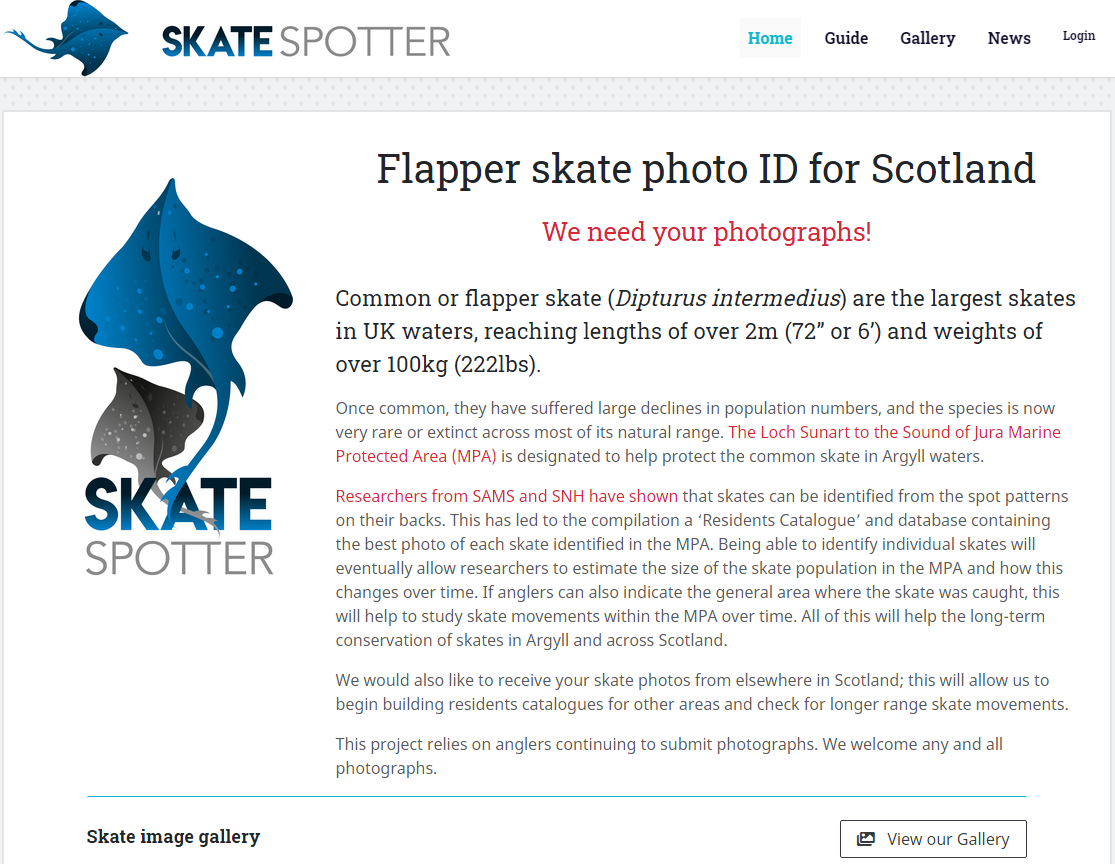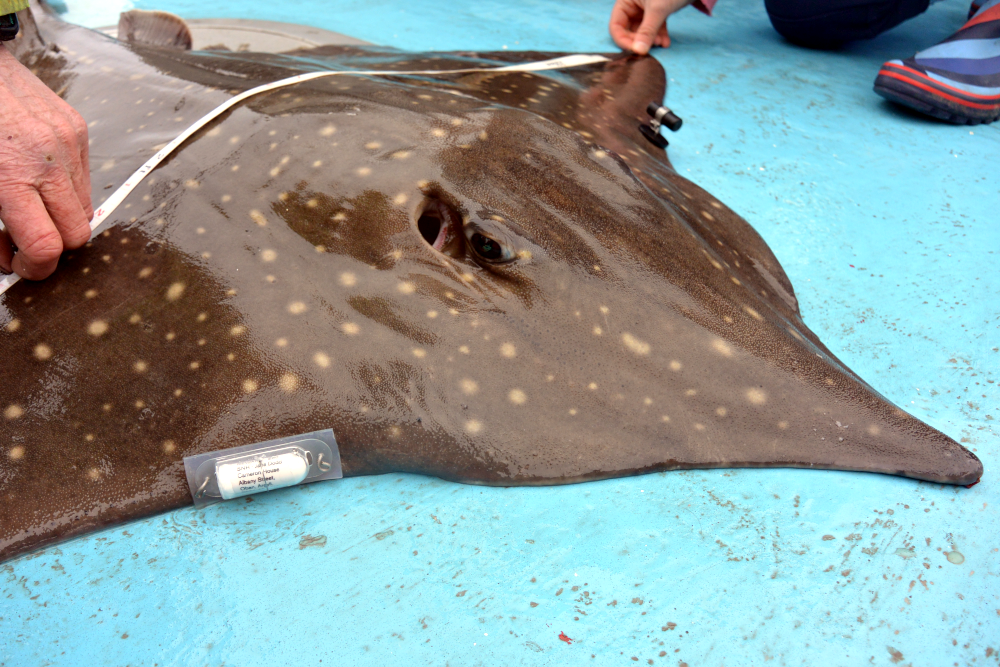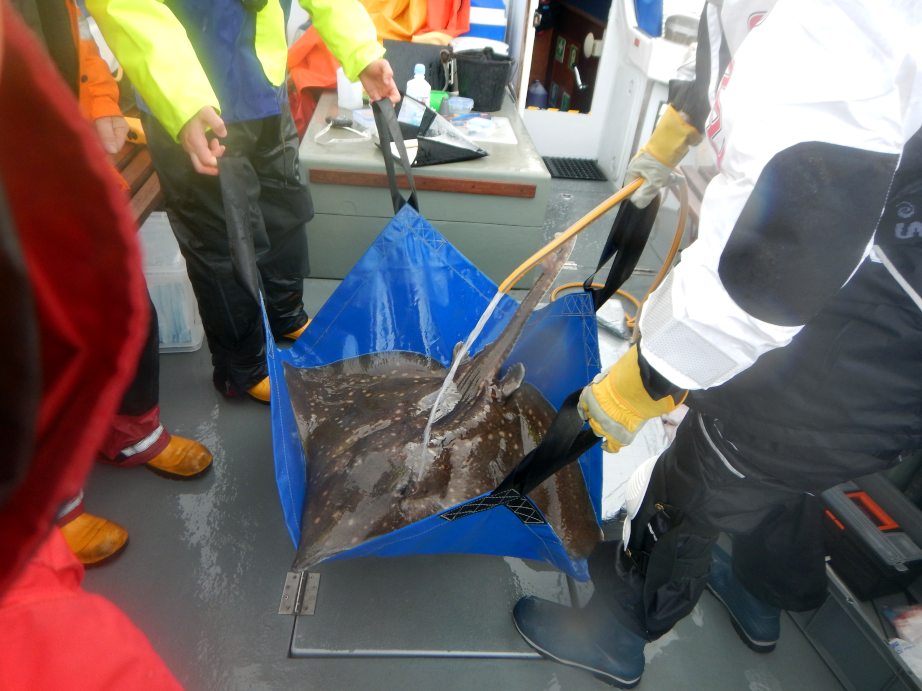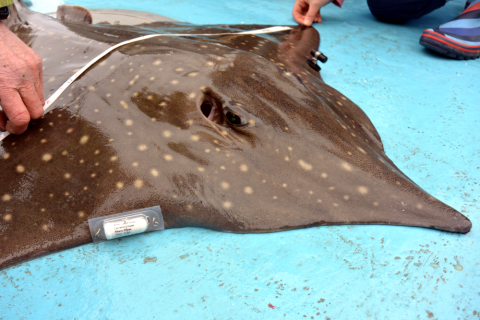Flapper skate (sometimes referred to as common skate) is listed on the International Union for Conservation of Nature (IUCN) red list as Critically Endangered. Genetic research published in 2009 (Iglesias et al., 2009) revealed that the common skate Dipturus batis is actually two species D. intermedius (known commonly as the flapper skate) and D. flossada (known as the blue skate). Collation and review of tag recapture data collected by recreational anglers dating back to the 1970s carried out by the Sea Angling Conservation Network and Scottish Natural Heritage in 2010 / 2011 showed that flapper skate although described as extinct in England and the North Sea still existed in significant numbers in the coastal waters of Argyll, specifically the Sound of Mull, the Firth of Lorn and the Sound of Jura. Flapper skate were therefore listed as a Marine Protected Area (MPA) search feature (a species for which MPAs should be designated) and as a Priority Marine Feature (habitats and species that are considered to be marine nature conservation priorities) for Scotland.
The Loch Sunart to the Sound of Jura MPA originated from a third-party proposal submitted by the Scottish Sea Angling Conservation Network (SSACN). Flapper skate tagging records (capture-mark-recapture) collected by recreational sea anglers as part of the Scottish Shark Tagging Programme (SSTP) were combined with historical records from Glasgow Museum and the UK Shark Tagging Programme to support the case for designation.
Sea anglers also worked with scientists from Marine Scotland Science (MSS) to track movements of flapper skate in the Sound of Jura (using an acoustic array) in 2012-2013 and to gain an insight into the depth zones used by individual fish using data storage tags (Neat et al., 2014). The MPA was subsequently designated in 2014 and fisheries management measures were introduced in 2016. The fisheries management measures include areas completely closed to mobile fishing gear to prevent bycatch of skate and areas that are open only seasonally and where tickler chains (the heavy chains on the base of bottom contact mobile gear) are removed. Removal of tickler chains from dredges and trawls has been found to reduce mortality when skate are captured as bycatch (Kynoch et al., 2015).
Since 2016, recreational anglers have been helping Scottish Natural Heritage, MSS, the Scottish Association for Marine Science (SAMS) and St Andrews University implement follow-on studies to help refine initial estimates of population size for the flapper skate within the site and set a baseline against which to determine the effectiveness of the new fisheries management measures. The work has three parts.
- A small group of charter skippers offering skate angling trips in the MPA have been taught to tag skate using PIT tags (see Figure 1). These are tiny electronic tags which are inserted under the skin like those used for pets. The skate are scanned upon capture and if no tag is present the fish is tagged. The skippers provide data to SNH and MSS on the location of capture, size and gender of the skate captured. The data can be used to describe skate movements, estimate survival and therefore the number of skate in the MPA. The PIT tag data will be used to estimate annual survival rates and population size of skate in the MPA. This will allow for the description of a population trend in the MPA to be developed and provide some insight into the effectiveness of the management measures (i.e. closing areas to mobile gear) in protecting the skate.

- In 2018 Steven Benjamins from SAMS proved that skate could be identified by their spot patterns by identifying multiple recaptures of 250 individuals in 400 photographs provided by Ronnie Campbell, a skate charter skipper (Benjamins et al., 2018). This study became the basis for Skatespotter (see Figure 2), an online database for skate photos launched by SNH and SAMS in 2019. Anglers can use Skatespotter to upload their photos (see Figure 3) for SNH / SAMS staff to match to the existing database and search for the skate they have captured by photo ID number, PIT tag number or SSTP number. This allows anglers without access to PIT tagging to contribute to the skate research. The photo database currently contains over 1,500 individual skate in the Firth of Lorn and the Sound of Jura. The data show that skate are very residential, often spending long periods on the same fishing mark. In particular, there is very little movement of skate (only five confirmed incidences so far) between the Firth of Lorn and the Sound of Jura. The photos have also allowed other variables to be investigated, such as how the skate heal from injuries over time and their parasite load. In 2019 SNH staff visited the Outer Hebrides and Shetland to meet with anglers and encourage the submission of photos from these areas. Separate photo databases have now been established for Shetland, the Outer Hebrides, and Orkney with the help of Orkney Skate Trust.

Figure 2: The Skatespotter website

-
In 2016-2017 SNH and MSS set up a further small acoustic array in the north of the Firth of Lorn and tagged 40 skate with acoustic tags and data storage tags to monitor their movements. The receivers recorded each time a tagged skate passed within about 500 m of a receiver and the data storage tags recorded the depth and temperature of the water the skate was passing through every 2 minutes. Using detailed bathymetry maps, the data from the data storage tags can be used to model the skate’s movement when it is out of range of the receivers. The data have already provided much more information about the limited movement of the animals in this area (Thorburn, Dodd & Neat, 2018) and continues to be analysed for a project at the University of St Andrews which will describe skate’s preferred depths and habitats and any seasonal changes in these preferences.
In 2018-2019 10 receivers were installed throughout the MPA and between 2018 and 2021 skate will be tagged with long-term (up to 10 years) tags as part of the Movement Ecology of Flapper Skate (MEFS) project led by the University of St Andrews in collaboration with the Royal Zoological Society of Scotland, SNH and MS. This will allow the skate in the MPA to be monitored over a longer time period and provide more information about the timing and preferred habitat for important life stage events. A fuller understanding of the ecology of skate, such as where and when egg laying occurs and preferred habitat for juveniles, is essential to inform management measures and ensure proper protection of the species in the MPA.

Skate Anglers have also helped us to develop a skate handling Best Practice Guide which has been published on the Skatespotter website. A number of them have also been provided with tarpaulins so that they can lift skate safely back into the water after capture (see Figure 5).

The seas around Scotland support a wide variety of fish species, some of which have been a source of livelihood, food and culture for centuries. Different components of the fish community have been assessed using different parameters. The Wider fish community assessment is based on 167 different species sampled by the International Bottom Trawl Survey designed to assess changes in demersal (bottom dwelling) fish communities. This includes a range of both commercial and non-commercial species. The Commercial fish assessment is based on the status of the eight species of greatest commercial value to Scotland (mackerel, herring, haddock, monkfish, cod, hake, whiting, saithe) using fishery and survey data. The Inshore fish (estuaries and reduced salinity sea lochs) is undertaken to determine the quality of transitional waters and the assessment is based on six representative inshore sites on the east and west coasts of Scotland. The Deep sea fish assessment is based on data from various scientific trawl surveys that provide a measure of species richness. Scotland has long been renowned for its Salmon and sea trout – two species that spend part of their life cycle at sea before returning to their natal river to spawn. The assessment of these stocks is based on returning fish (catches and count data) for 173 assessment areas which are primarily single river catchments. Altogether these various assessments provide an overview of the status of the different fish stocks, but much remains to be done to fully understand their behaviour and dynamics. The Case study: Basking sharks in Scottish waters for example describes how the use of cutting-edge technologies has greatly increased our understanding of the distribution, migration and behaviour of the basking shark (the second largest fish in the ocean) that frequent the waters off the west coast of Scotland. Similarly, the Case Study: Flapper skate – Loch Sunart to the Sound of Jura MPA describes how a capture-tag-recapture project involving recreational sea anglers, data storage tags and acoustic arrays have greatly improved our understanding of the ecology of the skate and consequently informed the necessary management measures needed to ensure their protection. The Case study: Sandeels in Scottish waters describes this fish stock that is an important component of the food web.
The seas around Scotland are home to a wide variety of animals and plants and are of international importance as a stronghold for many species. Whilst the protection of the wider environment through the management of various activities is essential, Marine Protected Areas (MPAs) have an equally important role to play in the protection and conservation of key habitats and species. There are now 230 MPAs covering 37% of Scotland’s marine environment (at December 2020, it was 22% in 2018 at the end of the assessment period) comprising MPAs for nature conservation (Nature Conservation MPAs; Special Areas of Conservation (SACs); Special Protection Areas (SPAs); Sites of Special Scientific Interest (SSSIs); and Ramsar sites), MPAs for other purposes (Demonstration and Research MPAs; and Historic MPAs), and Other Area-based Measures. Work continues to implement all the necessary management measures and the on-going monitoring necessary to determine the effectiveness of the protection afforded by the MPAs. The Case study: Protecting the Loch Carron flame shell beds documents the emergency measures put in place to prevent further damage after scallop dredgers destroyed part of the bed. In other cases, it is apparent that prevention is better than cure – the Case study: Persistent damage to the Loch Creran serpulid reefs where damage first recorded in 1998 still shows little evidence of recovery. The Case study: Flapper skate – Loch Sunart to the Sound of Jura MPA describes how the on-going monitoring involving recreational anglers has not only improved our understanding of the ecology but also the information necessary for determining the management measures needed to ensure their protection.
Perhaps one of the greatest challenges is balancing the need for protection and therefore control of certain activities with the resulting possible socio-economic impacts. The Case study: Socio-economic impacts of marine protected areas describes the outcomes of an initial assessment of the evidence and views of the impact of MPA designation. These are some initial findings from only 2-3 years after designation and whilst there is evidence in some areas that fishing has been made more challenging there are also early signs of positive environmental and community impacts. The lessons from other parts of the world is that to get a full and balanced picture of the effects of MPA designation takes time.


